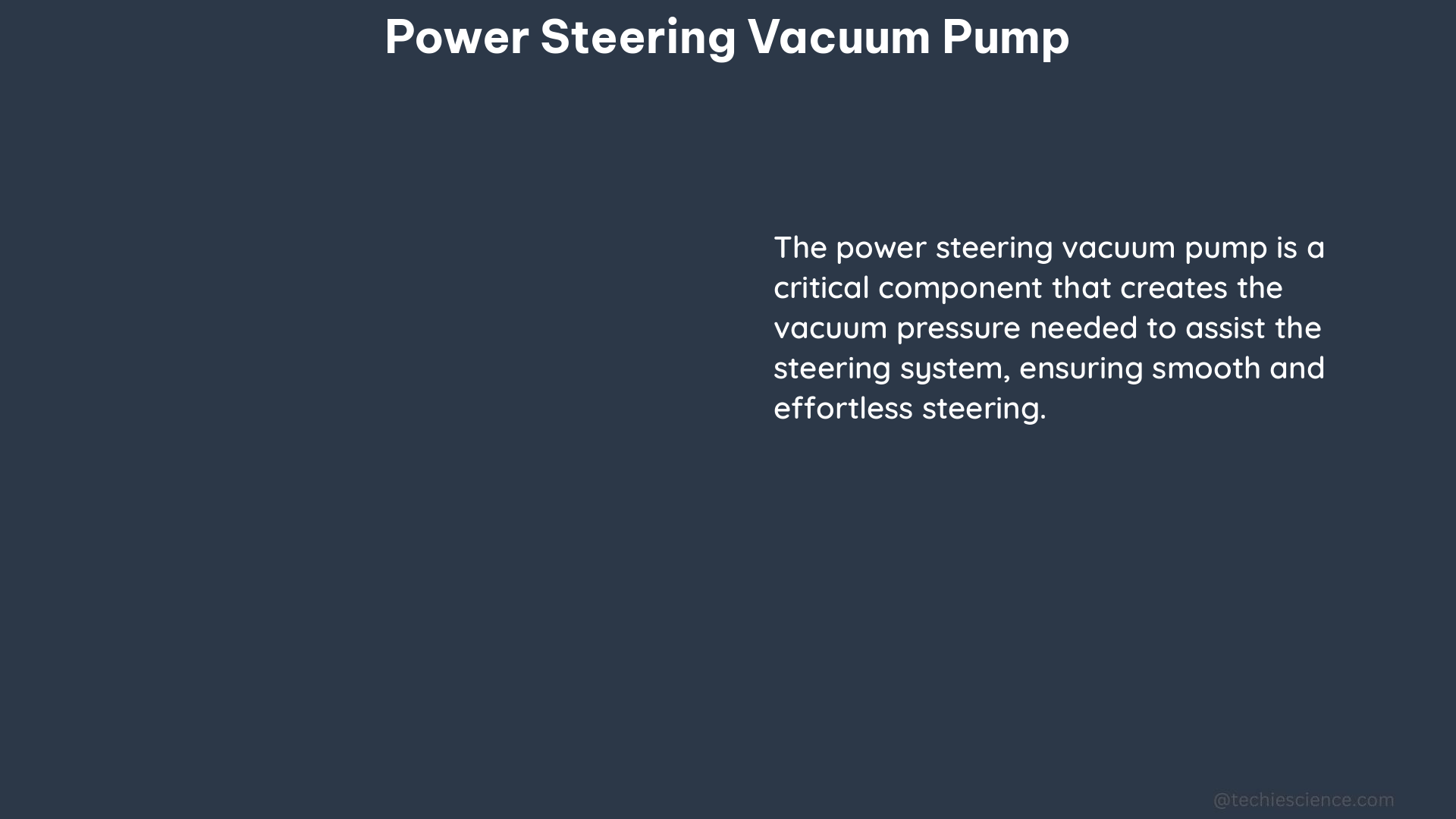The power steering vacuum pump is a critical component in many vehicles, particularly those equipped with hydraulic power steering systems. Its primary function is to create a vacuum that assists in the operation of the power steering system, making it easier for the driver to turn the vehicle’s wheels.
Technical Specifications of Power Steering Vacuum Pump
The power steering vacuum pump is typically driven by the engine’s crankshaft or camshaft and is responsible for generating a vacuum pressure range of approximately 18 to 22 inches of mercury (Hg). This pressure range is essential for the proper functioning of the power steering system, as it helps to reduce the effort required to turn the vehicle’s wheels.
The pump is designed to maintain a consistent vacuum pressure, which is crucial for the smooth and responsive operation of the power steering system. The vacuum pressure generated by the pump is used to actuate the power steering mechanism, reducing the amount of force required to turn the steering wheel.
Importance of Bleeding the Power Steering System

When it comes to the DIY aspect of the power steering vacuum pump, bleeding the system is a critical step in the installation process. Bleeding the system involves removing any air that may have entered the power steering system during installation or maintenance.
While some sources suggest that a vacuum pump may be necessary for this process, others argue that it is not strictly necessary. For example, one source on a Corvette forum suggests that a vacuum pump may not be necessary for bleeding the power steering system, and that simply following the normal bleeding procedure will suffice.
Another source on the same forum advises filling the system with fluid, working the wheel from lock to lock without the motor running, and then checking the fluid level. If the pump is noisy, this source advises not running it that way for long.
Measurable Data on Power Steering Vacuum Pump
In terms of measurable, quantifiable data, it is important to note that the power steering vacuum pump generates a specific range of vacuum pressure, typically in the range of 18 to 22 inches of mercury (Hg). This pressure range is essential for the proper functioning of the power steering system, as it helps to reduce the effort required to turn the vehicle’s wheels.
The vacuum pressure generated by the pump can be measured using a vacuum gauge, which can be connected to the power steering system. This measurement can be used to diagnose any issues with the vacuum pump or the power steering system as a whole.
Troubleshooting Power Steering Vacuum Pump Issues
If the power steering vacuum pump is not functioning properly, it can lead to a variety of issues with the power steering system. Some common symptoms of a malfunctioning vacuum pump include:
-
Increased steering effort: If the vacuum pump is not generating enough vacuum pressure, the power steering system will not be able to provide the necessary assistance, resulting in increased steering effort.
-
Noisy operation: A faulty vacuum pump may produce unusual noises, such as whining, grinding, or clicking sounds, which can indicate a problem with the pump’s internal components.
-
Fluid leaks: A vacuum pump that is not properly sealed can allow power steering fluid to leak, leading to a loss of fluid and potential damage to the system.
-
Reduced fuel efficiency: A malfunctioning vacuum pump can also impact the vehicle’s fuel efficiency, as the engine has to work harder to turn the power steering pump.
To diagnose and address these issues, it is important to follow a systematic troubleshooting process, which may involve checking the vacuum pressure, inspecting the pump for signs of wear or damage, and potentially replacing the vacuum pump if necessary.
Conclusion
The power steering vacuum pump is a critical component in many vehicles, responsible for generating the vacuum pressure necessary for the proper functioning of the power steering system. By understanding the technical specifications, importance of bleeding the system, and common troubleshooting techniques, DIY enthusiasts can effectively maintain and repair their power steering vacuum pumps, ensuring a smooth and responsive driving experience.
References:
– Is Vacuum Necessary when bleeding Power Steering? – Corvette Forum
– Does the vacuum pump have anything to do with power – JustAnswer
– Will deleting the gear-driven pump for power steering and vacuum … – Mechanics Stack Exchange
– Vacuum Pump Power Steering Pump Trouble – Cummins Forum
– Hydroboost/Power Steering/Vacuum Pump Question – Ford Trucks Forum

The lambdageeks.com Core SME Team is a group of experienced subject matter experts from diverse scientific and technical fields including Physics, Chemistry, Technology,Electronics & Electrical Engineering, Automotive, Mechanical Engineering. Our team collaborates to create high-quality, well-researched articles on a wide range of science and technology topics for the lambdageeks.com website.
All Our Senior SME are having more than 7 Years of experience in the respective fields . They are either Working Industry Professionals or assocaited With different Universities. Refer Our Authors Page to get to know About our Core SMEs.